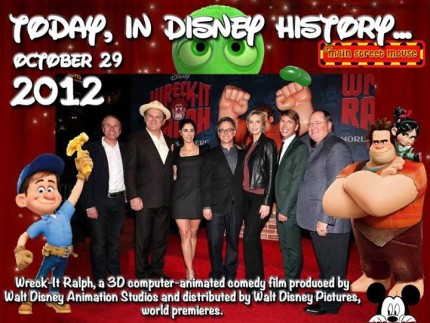Today In Disney History ~ October 29th
From Wiki:
Wreck-It Ralph is a 2012 American 3D computer-animated fantasy-comedy film produced by Walt Disney Animation Studios and released by Walt Disney Pictures. It is the 52nd animated feature in the Walt Disney Animated Classics series. The film was directed by Rich Moore, who has directed episodes of The Simpsons and Futurama, and the screenplay was written by Jennifer Lee and Phil Johnston from a story by Moore, Johnston and Jim Reardon. John Lasseter served as the executive producer. The film features the voices of John C. Reilly, Sarah Silverman, Jack McBrayer, and Jane Lynch. The film tells the story of the eponymous arcade game villain who rebels against his role and dreams of becoming a hero. He travels between games in the arcade, and ultimately must eliminate a dire threat that could affect the entire arcade, and one that Ralph himself inadvertently started.
Wreck-It Ralph premiered at the El Capitan Theatre on October 29, 2012, and went into general release on November 2. The film has earned $471 million in worldwide box office revenue, $189 million of which was earned in the United States and Canada; it was met with critical and commercial success, winning the Annie Award for Best Animated Feature and receiving nominations for the Golden Globe Award for Best Animated Feature Film and the Academy Award for Best Animated Feature. Wreck-It Ralph was released on Blu-ray and DVD on March 5, 2013.
In addition to the spoken roles, Wreck-It Ralph contains a number of other video game references, including characters and visual gags. The video game villains at the support meeting, in addition to those mentioned above, include: Bowser from the Mario franchise, Doctor Eggman from Sonic the Hedgehog, and Neff from Altered Beast. Additionally, the game cabinet of the Fix It Felix, Jr. arcade game is stylized to strongly resemble the cabinet of the original Nintendo Donkey Kong arcade game, with Ralph and Felix taking similar poses as Donkey Kong and Mario, respectively. Characters from Q*bert, including Q*bert, Coily, Slick, Sam, and Ugg, are shown as “homeless” characters and later taken in by Ralph and Felix into their game (Q*bert also speaks to Felix at one point using the signature synthesized gibberish and word-balloon symbols from his game, called Q*bert-ese). Scenes in Game Central Station and Tapper’s bar include Chun-Li, Cammy and Blanka from Street Fighter, Pac-Man, Blinky, Pinky, and Inky from Pac-Man, the Paperboy from Paperboy, the two paddles and the ball from Pong, Dig Dug, a Pooka, and a Fygar from Dig Dug, The Qix from Qix Frogger from Frogger, and Peter Pepper from BurgerTime. Additionally, Lara Croft and Mario are referenced, but not seen.
Additional references are based on sight gags. The residents of Niceland and the bartender from Tapper are animated using a jerky motion that spoofs the limited animation cycles of the sprites of many eight- and sixteen-bit arcade games. King Candy uses the Konami Code on an NES controller to access the programming of Sugar Rush. Throughout Game Central Station is graffiti that includes “Aerith lives” (referencing the character of Aerith Gainsborough from Final Fantasy VII),”All your base are belong to us” (an “Engrish” phrase popularized from the game Zero Wing), “Sheng Long Was Here” (referencing an April Fool’s joke around a made-up character Sheng Long from Street Fighter), and “Jenkins” (a nod to the popular Leeroy Jenkins meme from World of Warcraft). There is also a reference to the Metal Gear series when Ralph is searching for a medal in Tapper’s Lost and found, finding first a Super Mushroom from the Mario franchise, and then Metal Gear’s “Exclamation point” (with the corresponding sound effect from the game). Mr. Litwak wears a black and white striped referee’s shirt, a nod to the iconic outfit of Twin Galaxies founder Walter Day. One of the songs in the credits is an original work from Buckner and Garcia, previously famous for writing video game-themed songs in the 1980s.[32] The Walt Disney Animation Studios opening logo is animated in an 8-bit pixelated fashion, whereas the Walt Disney Pictures closing production logo appears in a glitched state, a reference to the kill screen from many early arcade games such as Pac-Man.
TMSM Today in Graphic by Sherry Rinaldi DeHart
- EPCOT Food & Wine Fest Dates, Details Announced - April 23, 2024
- Daydream Believing! - April 19, 2024
- Disney Adventure World: Disneyland Paris Reimagines 2nd Park - April 12, 2024





